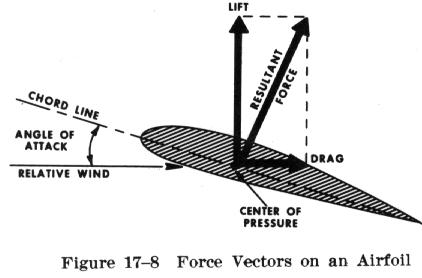| Pressure Distribution
| From experiments conducted on wind tunnel models and
on full size airplanes, it has been determined that as air flows along the
surface of a wing at different angles of attack there are regions along
the surface where the pressure is negative, or less than atmospheric, and
regions where the pressure is positive, or greater than atmospheric. This
negative pressure on the upper surface creates a relatively larger force
on the wing than is caused by the positive pressure resulting from the air
striking the lower wing surface. Figure 17-7 shows the pressure
distribution along an airfoil at three different angles of attack. In
general, at high angles of attack the center of pressure moves forward,
while at low angles of attack the center of pressure moves aft. In the
design of wing structures this center of pressure travel is very
important, since it affects the position of the airloads imposed on the
wing structure in low angle of attack conditions and high angle of attack
conditions. The airplane's aerodynamic balance and controllability are
governed by changes in the center of pressure.
The center of pressure is determined through calculation and wind
tunnel tests by varying the airfoil's angle of attack through normal
operating extremes. As the angle of attack is changed, so are the various
pressure distribution characteristics (Fig. 17-7). Positive (+) and
negative (-) pressure forces are totaled for each angle of attack and the
resultant force is obtained. The total resultant pressure is |
| represented by the resultant force
vector shown in Fig. 17-8. The point of application of this force vector is
termed the "center of pressure" (CP). For any given angle of attack, the center
of pressure is the point where the resultant force crosses the chord line. This
point is expressed as a percentage of the chord of the airfoil. A center of
pressure at 30 percent of a 60 inch chord would be 18 inches aft of the wing's
leading edge. It would appear then that if the designer would place the wing so
that its center of pressure was at the airplane's center of gravity, the
airplane would always balance. The difficulty arises, however, that the location
of the center of pressure changes with change in the airfoil's angle of attack
(Fig. 17-9).
 |
In the airplane's normal range of flight attitudes, if the angle of
attack is increased, the center of pressure moves forward; and if
decreased, it moves rearward. Since the center of gravity is fixed at one
point, it is evident that as the angle of attack increases, the center of
lift (CP) moves ahead of the center of gravity, creating a force which
tends to raise the nose of the airplane or tends to increase the angle of
attack still more. On the other hand, if the angle of attack is decreased,
the center of lift (CP) moves aft and tends to decrease the angle a
greater amount. It is seen then, that the ordinary airfoil is inherently
unstable, and that an auxiliary device, such as the horizontal tail
surface, must be added to make the airplane balance longitudinally. The
balancing forces imparted by the tail surfaces will be discussed later in
the chapter. |
| The balance of an airplane in flight depends, therefore,
on the relative position of the center of gravity (CG) and the center of
pressure (CP) of the airfoil. Experience has shown that an airplane with
the center of gravity in the vicinity of 20 percent of the wing chord can
be made to balance and fly satisfactorily.
The tapered wing presents a variety of wing chords
throughout the span of the wing. It becomes necessary then, to specify
some chord about which the point of balance can be expressed. This chord,
known as the mean aerodynamic chord (MAC), usually is defined as the chord
of an imaginary untapered wing which would have the same center of
pressure characteristics as the wing in question.
Airplane loading and weight distribution also affect
center of gravity and cause additional forces which in turn affect
airplane balance. This will be discussed in a later section.
|
|
 |
FAATest.com
- Aviation Library
Dauntless
Software hosts and maintains this library as a service to pilots
and aspiring pilots worldwide. Click
here for ways to show your appreciation for this service.
While much of this material comes from the FAA, parts of it are (c) Dauntless Software, all rights reserved. Webmasters: please
do not link directly to individual books in this library--rather,
please link to our main web page at www.dauntless-soft.com or
www.faatest.com. Thanks! |
|